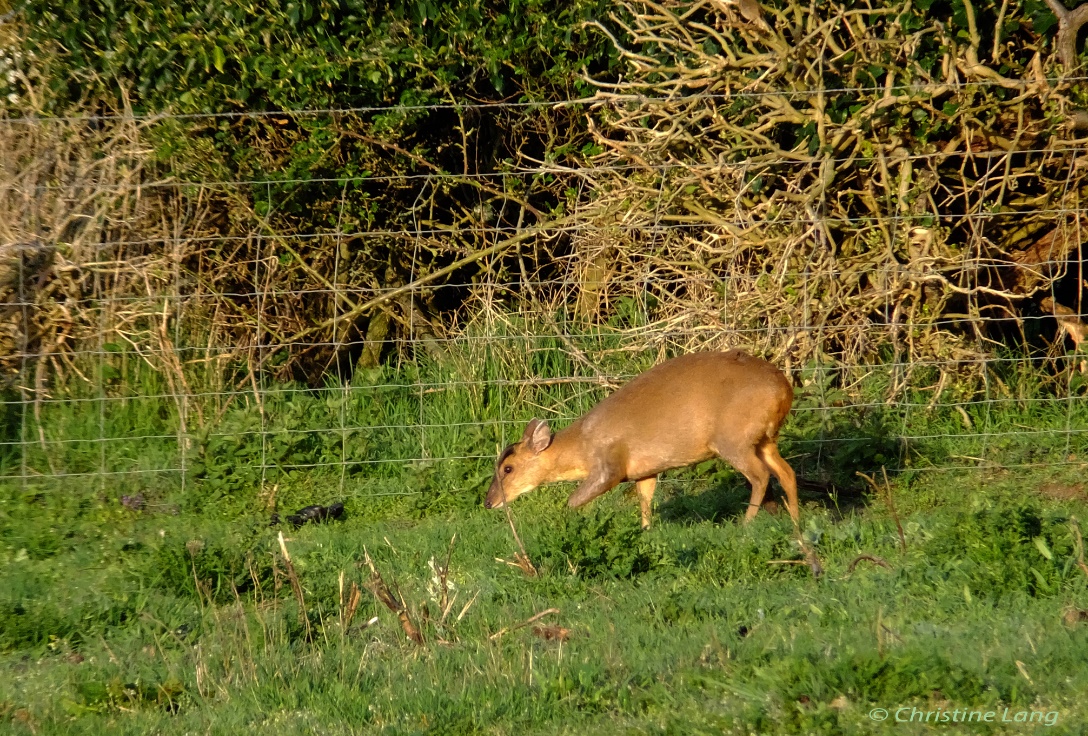



There are four species of Deer found in Thetford Forest namely Red Deer (Cervus elaphus), Roe Deer (Capreolus capreolus), Fallow Deer (Dama dama) and Muntjac (Muntiacus reevesi). The Red and Roe Deer are the only two species indigenous to the UK although Fallow is now recognised as naturalised.
All the Deer are ungulates and are most active at dawn and dusk, where they will often be feeding out in the open. A large part of the daytime is spent hidden in dense areas of woodland. Also, with these four species only the males have antlers which they shed once a year.
The Deer are managed by a team of wildlife rangers who maintain the health and control the population by selective culling of the deer. This is necessary because deer damage young and mature trees by browsing and rubbing their antlers on the tree trunks. Often, new plantations are fenced to protect the young trees.
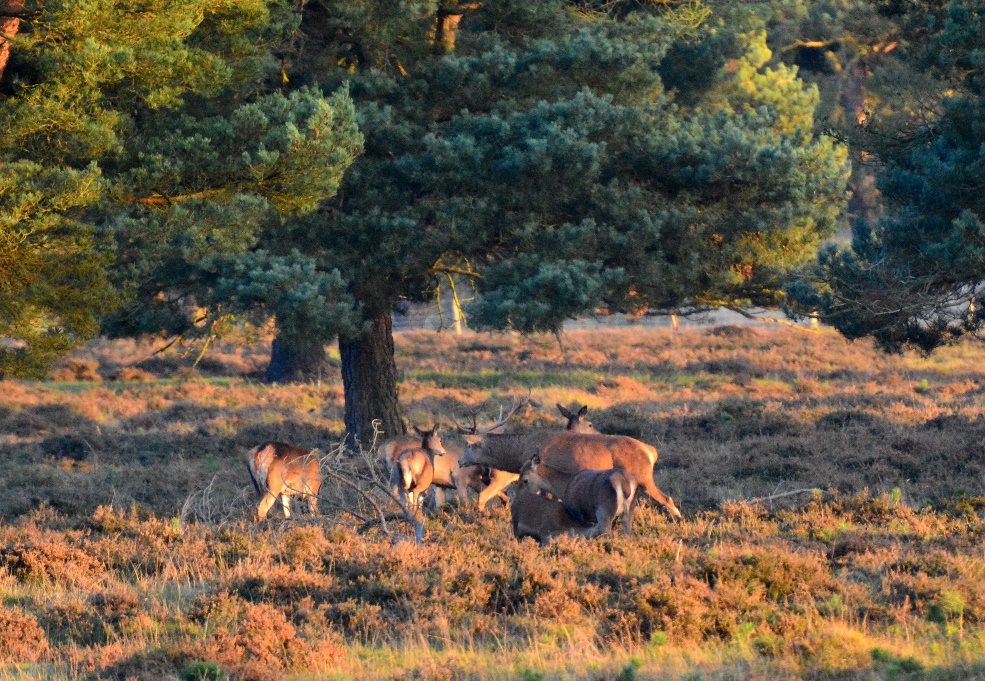
The largest of our native deer, the Red Deer (Cervus elaphus) are thought to have migrated from Europe about 11,000 years ago. They inhabited the woodlands and heathlands that had grown up since the melting of the last Ice age. The Breckland woodlands consisted Scots Pine, Beech, Yew, Spruce and Oak and were ideal habitats for deer.
Mesolithic man (9000-4000yrs ago) was living in the Brecklands as a hunter gatherer, before Neolithic man settled in the area (4000-2500 yrs ago). These settlers started to clear the land for growing emmer wheat and barley. Clearing the land and hunting would have had a detrimental effect on the populations of deer in the area
Neolithic people also mined flint at what is now known as Grimes Graves and made use of Red Deer antlers as Pick Axes. In W.G. Clarke's book 'In Breckland Wilds' he writes about members of the 'Prehistoric Society of East Anglia' excavating some of the shafts at Grimes Graves in 1914. At one of these excavations they found 244 Antler Picks. In A.J. Forest's book 'Masters of Flint' it is estimated that 25,000 Red Deer Stags were either killed or contributed by natural discard their sets of Antlers
for use in the flint mines during this era.

As land use changed over the centuries and large estates appeared, Red Deer were kept in enclosures on these estates. For sport they were loaded on to carts and taken into the forest to be chased, then rounded up and taken back to the enclosure. They were known as 'Carted Deer'. This form of hunting was popular in the Nineteenth and early Twentieth Century. It is thought that the Red Deer found in England today are descendants of introduced Eastern European wild stock and are larger than the Red Deer found in Scotland. It is believed that to improve the Red Deer they were crossbred with Elk/Wapiti (Cervus canadensis).

A few statistics. Red Deer males are known as 'Stags' and stand approx. 107-137cm at the shoulder and weigh between 100-300kg. They shed their antlers around March and start to grow a new set ready for the next breeding season called the 'rut'. This is usually from September to November, where handsome mature Stags resplendent with their new grown antlers vie with each other for a harem of females.
As the males mature their antlers get larger each year and can be up to a metre across and each antler could weigh between 6-15kg. Their voices also deepen with age. The males roar and grunt during the Rut. The Female Red Deer are known as 'Hinds' and stand approx. 107-122 cm at the shoulder and weigh between 60 -120kg. The Deer graze on grasses, dwarf shrubs, heather and tree shoots, but when food is limited e.g. in winter, they can be seen grazing on winter sown agricultural crops. The young (calves) are born about in early summer.
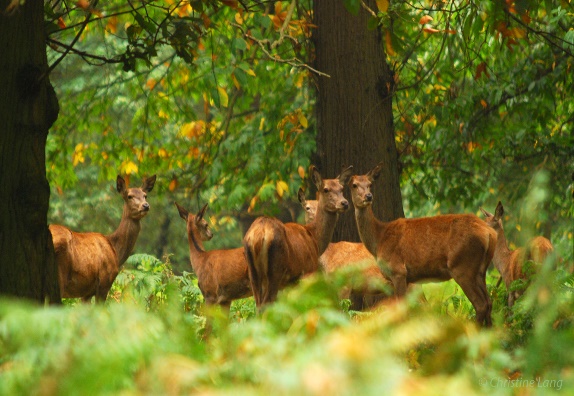
The other native species is the Roe Deer (Capreolus capreolus). Like Red Deer, they arrived in the British Isles after the end of the last Ice Age, and evidence shows that they were hunted by Mesolithic settlers (10,000-6000 yrs. ago). Their numbers were affected by deforestation and hunting, they were almost extinct in the Brecklands by the 18th century. Several pairs of Roe Deer were introduced in the 1880s from Wurttemberg in Germany by Colonel Mackenzie of Downham Hall and with the creation of Thetford Forest and further woodland plantings in 1920s and 30s their numbers have increased.
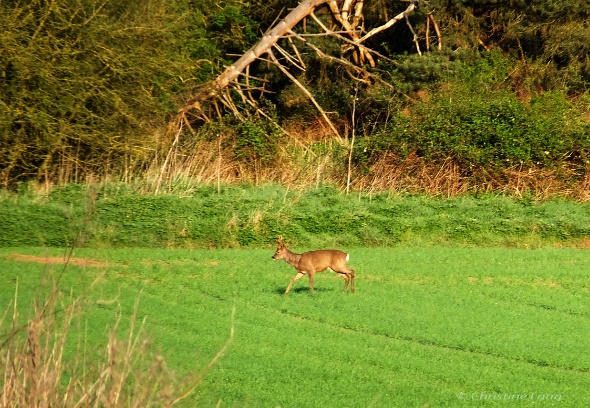
A few statistics. Male Roe Deer known as 'Bucks' and females known as 'Does' are very similar in size. At the shoulder they stand 60-75cm and weigh between 10-25kg. Only the Buck has Antlers which are 'Rugose' (ridge/rough), 3 pronged and about 30cm in length. The rut is between mid-July to mid-August, but the Bucks will maintain a territory around Does before the rut starts. Courtship is interesting as the Buck will chase the Doe around for some time before the Doe is ready to mate. However, after mating the fertilised egg will not implant in the womb until the following January. This makes the total gestational period of 9 months. Split 4 months of no embryonic growth and 5 months of foetal growth. The 'Kids' are born in May-June and there might be 2 or 3. Roe Deer are browsers and eat herbs, brambles, ivy, heather, bilberry and young tree shoots of which the deciduous hardwoods such as Beech are a favourite. They will browse on them to within a few centimetres of the ground. If Roe Deer are seen, they are often in small family groups.
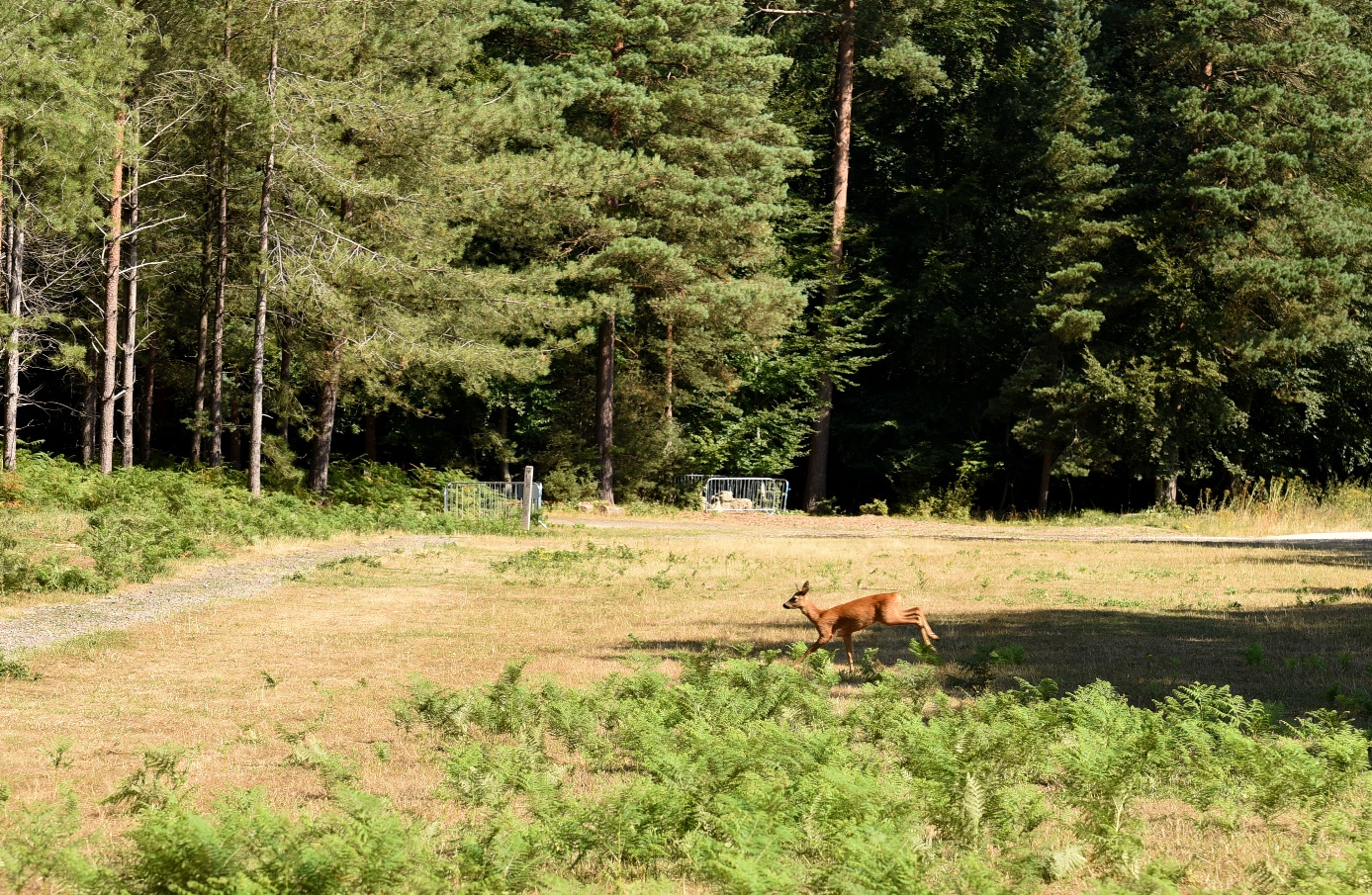
The next Species of deer is the Fallow Deer (Dama dama). First seen in the Brecklands during the 1st World War. The Fallow Deer seen in the Brecklands today are thought to be descendants of escapees from the Livermere Estate. There are several distinct colour variations aside from the regular tan with white spots. They can be black across the back and slightly paler below. The White variation is often called a 'White Hart' These are not true albinos as they usually have the normal eye colour.

The Romans are thought to have brought some Fallow Deer to Britain when they occupied this country. These deer were enclosed and kept as an ornamental exotic species to be admired and also bred for meat. When the Roman Empire collapsed, the deer they had introduced died out as they were not as robust as the species of Fallow Deer introduced by the Normans in the 11th Century. These robust deer were also enclosed and were kept for hunting. Over the centuries many large estates kept this ornamental breed in their parklands. By 1990 there were thought to be about 4000 Fallow in Thetford Forest compared to less than 200 each of Red Deer and Roe Deer.
A few statistics. Adult male Fallow Deer are known as 'Bucks' and are between 84-94cm at the shoulder and weigh between 46-94kgs. The antlers increase in size up to approx. 70cm when the males reach maturity at 3-4yrs old They are distinctly palmate with many prongs. Female Fallow Deer are known as 'Does' and stand between 71 and 91cm at the shoulder. They weigh between 35-56kg. During the Rut the Bucks can be heard making a deep grunting/groaning sound. The more mature the Buck the deeper his voice. It is said that females will gravitate towards Bucks with deep voices! Their Fawns are born in June or July.
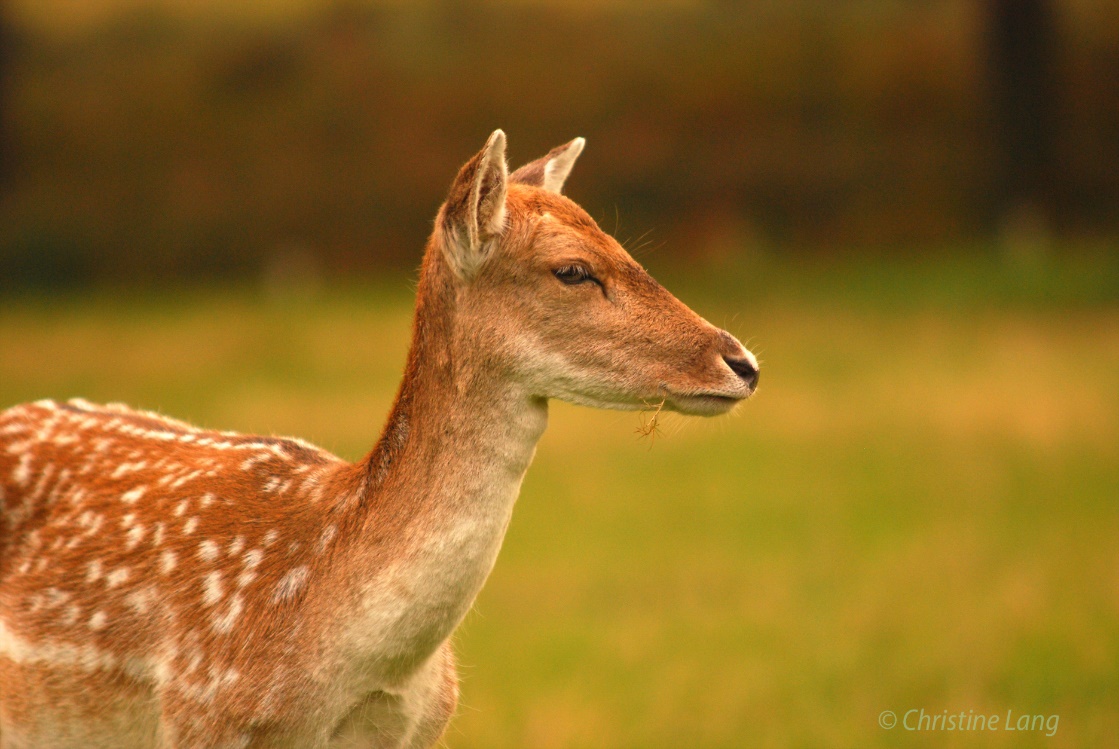
The Reeve's Muntjac Deer (Muntiacus reevesi) was named in 1812 after John Reeve of the East India company and is a 20th Century introduction from South East Asia. They started to appear in Thetford Forest by 1953 after escaping from Estates such as Woburn, and possibly deliberate releases. Other species of Muntjac had been brought to this country but did not do well in the British climate. The Reeve's Muntjac adapted well and, because of its ability to breed all year round, it is now widespread in England. They have small territories and are usually solitary. Their grazing habits can have significant impact in areas where there are plants of conservation importance, but they are also found in scrubland and increasingly in urban areas.
A few statistics. The males (Bucks) stand approx. 44-52cm at the shoulder, weigh 10-18kg have small antlers approx. 10cm long on top of a fur covered pedicle (base). The antlers are unbranched. The males also have prominent upper canines (Tusks). The females (Does) stand about 43-52cm at the shoulder and weigh 9-16kg. Females are capable of breeding from the age of 7 months and usually produce one kid at a time. Like most species of deer, the coat of the young is spotted, this give suitable camouflage for the youngster hiding amongst vegetation while the doe is away. Their characteristic hunched appearance is because their haunches are higher than their shoulders. Muntjac also make a distinct barking sound which also gives them the nickname of 'Barking Deer'. If alarmed they can make a screaming sound. Does and Kids communicate with squeaks.
